 |
|
|
Popular topics on this page:
Heathkit AG-9A audio signal generator
Better phono jacks
No, today (June 6, 2006) is not 666
The remote computer has ended the connection
Internet Explorer closes suddenly when you click on a button
EnableVisualStyles broke my program
Astrophotos:
M13
M51
Jupiter's 2 red spots
Scroll down or press Ctrl-F to find other topics, or check previous months.
BOOK SALE - I'm selling off some scholarly books via Amazon Marketplace. Have a look!

|
2006
June
28-30
|
End of month
Cathy's back from Ecuador, no thanks to American Airlines, which made her return unduly
difficult by not allowing her enough time to clear customs and security in Miami.
(The situation was complicated by a thunderstorm that temporarily shut down the
Miami airport and sent everyone into confusion.) She was bumped to a later flight
and eventually dragged into Atlanta at 7 p.m., about 12 hours after leaving Quito.
Her pictures are great and I hope she'll let me post some of them soon.
[Note added June 30: It turned out the rest of the University of Georgia
group, 20 people, was behind Cathy, not ahead of her! They got an even later flight.
American Airlines wouldn't
hold a connecting flight when they knew that over 20 connecting passengers were
in the airport and trying to get to it!]
I'll close out the month now. Next month's Daily Notebook will have some minor changes
in its HTML format and will be completely kosher HTML 4.0.
Permanent link to this entry

|
 |
2006
June
27
|
Five-inch Jupiter

Here's a quick shot of Jupiter taken around 11 p.m. this evening
with my trusty Celestron 5 telescope (vintage 1980).
The relatively low-quality spur-gear drive in this telescope actually helped, because it moved
the image all over the CCD and eliminated any local imperfections.
I recorded about 2000 frames of video and aligned them with Registax.
You can see the Great and Little Red Spots (the latter perched right above the former);
they are probably about to merge.
Permanent link to this entry

|
 |
2006
June
25-26
|
The operating-system zoo
Last night we set up Artemis, Melody's old computer, as a dual-boot Windows 98 and XP system.
We also made sure that Frankenstein, an old computer made of cast-off parts (hence the name),
still runs. Frankenstein's CPU is a 66-MHz 486SLC, set up as a triple-boot system with
Windows NT, DOS, and OS/2 3.0.
Artemis is a 450-MHz Pentium with 512 MB RAM, supposedly a bit underpowered for Windows XP.
I expected that its original OS, Windows 98, would be faster and snappier on it than XP.
Not so! XP both installed and ran faster. Windows 98 has a tendency to hang which
is totally absent from XP. And aside from performance, the big difference
we noticed is that XP didn't need any device drivers, whereas with 98, we had to install device
drivers for the network card and the video card. The lack of a network device driver raises a
chicken-and-egg problem with a computer that wants to get on the Internet during installation.
As for Frankenstein... In its heyday, this motherboard lived in a computer named Athena which was
set up to dual-boot DOS (with Windows 3) and OS/2. We used OS/2, back around 1994, to run a
large-memory version of LaTeX typesetting software. Before Windows 95, you couldn't do that easily
in Windows.
OS/2 was a strange combination of technical excellence and user-unfriendliness.
Its user interface involved windows that would "minimize" into complete invisibility,
getting lost. And there were no good software development tools at first.
There was a Borland C++ compiler, and I had it, but there was nothing like Delphi or Visual Basic.
If I had been IBM, I would have paid Borland to port Delphi to OS/2 the moment it came out.
That would have ensured OS/2 a share of the market, just the way Microsoft Basic
gave DOS the breath of life back in 1982 (edging out CP/M-86 and UCSD P-System).
OS/2 was one of two products from the same Microsoft-IBM joint project. The other was
Windows NT, which evolved into Windows 2000, XP, and Vista. Because of their better user interface
and their compatibility with Windows 3 software, the Microsoft products won out, and OS/2 is
no longer on the market. But OS/2 had a reputation for high reliability and is still used in
automatic teller machines, cash registers, and the like.
I have never run OS/2 on a computer that is really fast enough for it. Maybe I should try.
Permanent link to this entry

|
 |
2006
June
23-24
|
Miscellany
Opera 9 (the web browser) is out,
but it has trouble displaying parts of this page correctly, and my
clever hack to customize the search menu
does not work with it.
I urge caution.
[Note added June 25: You can drop back to Opera 8.54 by simply installing Opera 8.54 on top
of Opera 9, thereby replacing it, and then copying the right version of search.ini into place.
Search.ini is the only configuration file that Opera 9 changes, as far as I can tell.]
Electronics book of the day:
Hans Camenzind's
Designing Analog Chips,
which you can read (entire) on line
here.
The book is actually for people who use chips, not just design them, and it includes the
clearest explanations I've ever seen of how diodes and transistors work,
along with lots of lucid discussion of circuit concepts,
as well as the whole story of how Camenzind invented the 555 timer.
Artificial stupidity?
Here is a specimen
of one of the lower forms of automated language understanding.
Also from Jim Mischel, why you should
avoid U3 technology
in USB flash drives. (It tampers with your computer!)
I am beta-testing
Windows Vista
(see also
here)
and have had no problems so far except a few device drivers.
In general, if the driver supplied with Vista doesn't work,
you should download the manufacturer's current Windows XP driver
and use that.
Permanent link to this entry

|
 |
2006
June
21-22
|
EnableVisualStyles broke my program
Symptom: A .NET program starts malfunctioning badly when
EnableVisualStyles is added.
Recall that EnableVisualStyles is what you put into a program
so that its buttons will pick up the currently selected Windows "style" or "theme,"
such as the rounded-corner buttons of Windows XP.


Background: My program handles the Paint event of the afflicted window,
and in the Paint event handler sets the focus to a different button.
Explanation: The Paint event arises whenever there is any change
to the appearance of the window, and when you turn on visual styles,
these visible changes become a lot more frequent.
As a result, the Paint event handler starts being actuated at times
when it formerly wasn't.
In my case, I was using the event handler to set the focus to the button that the
user would most likely need to press next.
But with visual styles turned on, buttons change color when the mouse cursor
touches them, so the Paint event got called whenever the user
tried to press any button.
As a result, the focus always got set to the "right" button
before the user could press the "wrong" one, and pressing the "wrong" button had no
effect!
Cure: Redesign the program so that actions affecting the ability to press a button
do not occur while the user is starting to press the button.
Permanent link to this entry

|
 |
2006
June
20
|
A timely warning
Do not give out personal information (account numbers, Social Security Number, etc.)
to anyone who calls you on the telephone, no matter who they claim to be.
They want your information so they can use it for identity fraud.
For years, con artists have made calls claiming to be your bank or your creditors.
The latest version of the scam is that they claim to be the police and tell you that
you are going to be arrested for not showing up for jury duty.
The only proper response is, "OK, tell me what court or police department to call, and
I'll look up your number and call you right back."
And no matter what he says, remember he's just a voice on the phone and probably
doesn't even know where you're located. Call the real police.
Permanent link to this entry

|
 |
2006
June
19
|
Quote for the day
Science can purify religion from error and superstition;
religion can purify science from idolatry and false absolutes.
— Pope John Paul II.
Permanent link to this entry

|
 |
2006
June
18
|
Jupiter's two red spots
 As everybody knows by now, Jupiter has grown a
second Great Red Spot.
Some Americans are calling it "Red Spot Jr." but I want to follow a traditional English
naming convention and call it the Little Red Spot (cf. Great St. Mary's and Little St. Mary's,
Great Gidding and Little Gidding, etc.).
As everybody knows by now, Jupiter has grown a
second Great Red Spot.
Some Americans are calling it "Red Spot Jr." but I want to follow a traditional English
naming convention and call it the Little Red Spot (cf. Great St. Mary's and Little St. Mary's,
Great Gidding and Little Gidding, etc.).
This picture was taken about 9:10 p.m. tonight (June 18) with my 8-inch telescope.
It's not the finest Jupiter image I've ever produced, but you can see the Little Red Spot
just above and to the right of the Great Red Spot.
What we've learned is that, apparently, any storm on Jupiter can turn red.
The Little Red Spot was a normal white oval until recently.
It is approaching the Great Red Spot and may merge with it.
Permanent link to this entry
Some PC CPU fan lore
My latest attempts to
make Minerva quieter
revolve around the CPU cooling fan.
The other day I determined that the CPU fan was now the main source of noise in Minerva
and that it was getting louder day by day.
What's going on?
Well... The CPU fan speed is regulated by the motherboard, and the hotter the CPU gets, the faster
the fan runs.
So if the CPU gets hotter, the fan gets louder.


I took the whole assembly apart and saw that the heat sink compound joining the CPU to the
heat sink had deteriorated. So — fool that I am — I replaced it with ordinary
heat-sink grease, the white stuff we've been using since the 1960s.
More noise. Warmer CPU. (I can read the temperature using ASUS utility software.)
Today, seeing the folly of my ways, I went to Best Buy and got some
silver heat-sink compound,
basically powdered silver in silicone grease.
It conducts heat much better than conventional heat-sink grease,
and the CPU is happy again.
But the fan is still noisy, and I'm going to replace it with
this one, which is much quieter (40 vs. 19 dB).
During my experiments I figured out how to bench-test a CPU fan.
Here's the setup:

The output is a square wave. Multiply the frequency (in Hz) by 60 to get the RPM.
Or, if you just want to run the fan to see if it rattles, apply power to yellow and
black, and don't bother connecting the green wire to anything.
A "quiet cable" puts 3 1N4001 diodes in series with the yellow wire, reducing the voltage
by about 1.8 volts. That reduces the fan speed throughout the whole range —
which is desirable only if you're sure it's not going to overheat.
My present CPU fan is the one supplied by Intel with my Pentium 4 (Socket 478).
Intel's specifications are
here.
The CPU is supposed to run between 40 and 50 degrees C.
Permanent link to this entry

|
 |
2006
June
17
|
Many short notes
Non-Radio Shack: I was startled to see that the Radio Shack in Gwinnett Place Mall
is discontinuing all electronic parts except connectors, fuses, and the like.
No more resistors, capacitors, or ICs.
I think that is extremely short-sighted. I know they don't make a profit on components,
but the components are what keep a certain kind of customer coming in. They'll never
sell me an expensive cell phone (which is apparently now their main goal) if I never come
into the store.
Lo siento, Dos Punto Tres: For some time the oddest thing on the radio around
here has been Ciento Dos Punto Tres, which is Spanish for "102.3." The station plays
Mexican oom-pah-pah music and airs lots of commercials for local
businesses.
But now they've been outdone. Something in eastern Gwinnett County, on 97.9 MHz, broadcasts
in French — but not French I can understand much of.
(Or maybe The Unknown Tongue with occasional lapses into lucid French.)
I have no idea who they are or what they're up to.
[Note added June 30: I'm told this is a pirate station that relays
an Internet radio station in Haiti. The unknown tongue is Haitian Creole, and they do
indeed lapse into standard French some of the time.]
Better HTML: I learned HTML years ago and have been content to know only a small
subset of the language. This month's project is to bring my knowledge of HTML up to date.
Toward that end, I'm revising the HTML usage in this notebook.
The changes will be gradual and I hope they don't throw off the program that
some friends are using to convert the entries into RSS.
I'm going to stick with HTML, not XHTML.
Quieter PCs: The technology we long for is at
endpcnoise.com.
I shall very soon be getting a quieter CPU fan for Minerva,
probably from them.
Vista arrives: Microsoft Windows Vista, Beta 2, is currently installing itself
on a partition of Minerva's hard disk. As soon as it's done, I'm going to
edit the boot menu
so that XP remains the default.
(This is not the old familiar BOOT.INI.)
Permanent link to this entry

|
 |
2006
June
15-16
|
It's a book!

|
|
Our most successful book project is now in its 9th edition and
(if I'm counting right) 20th year. Click on the picture for more information,
including sample pages.
|

|
 |
2006
June
13-14
|
Fame again
I've made it into MAKE: Blog again.
Each of my 2 appearances there resulted in 4000 hits on the page that it referred to.
Also, this blog is starting to get several hundred hits a day, source unknown.
[Note added later: Found it. I'm in MAKE
yet again,
and the latest one points to a blog entry.]
Today (the 14th) was mostly spent in the AI Center's new electronics lab, which is now almost completely
set up and ready to use.
To make sure the tools work, I did some PIC microcontroller development this afternoon,
a new version of the Alcor telescope
drive controller which will provide faster slewing in right ascension and declination.
(No, that's not on the web page yet.)
To my surprise, noted astrophotographer
Chris Hetlage
came up and introduced himself to me as I was walking around Tate Plaza right after lunch.
He was checking his daughter into orientation as a new student at the University of Georgia.
Everybody, go look at his pictures – they're excellent.
See also this video
of a meteorite hitting the moon.
It was taken with equipment very similar to mine.
During major meteor showers, I ought to take continuous video of the dark portion of the moon
to see if I catch one.
The duration (over 1/10 second) distinguishes it from a cosmic ray hitting the camera,
which would also produce an isolated point of light.
At church this evening I gave
this talk.
I'm not sure it sat well with everyone.
Some people want me to make evolutionary biology go away
(or tell them they need not learn anything about it), and I'm not going to do that.
How many people balk at becoming Christians because they've been told – falsely –
that it will obligate them to reject a whole area of scientific discovery?
Permanent link to this entry

|
 |
2006
June
12
|
Fame, whimsy, a two-headed monster, Windows Vista, and WinFX
There... now you're wondering what on earth this entry could be about. Hang on.
Fame: One of my projects has made it into
MAKE: Blog at Make Magazine.
Whimsy: If you like strange machinery, look at
Hacked Gadgets.
Two-headed monster: We recently decommissioned a computer at home, and I grabbed
its flat-panel monitor and put it on Minerva (my main PC) alongside the existing one.
To support two displays, I had to get a new video card,
and this one was just $40 after rebate at Circuit City,
including the DVI-to-VGA adapter for the second monitor.
The NVIDIA driver allows separate adjustment of the color balance, contrast, brightness, and gamma
(curve shape) to make the two monitors match. I didn't get a perfect match, but at least they're not
terribly different after adjustment.
Windows Vista: I'm going to be beta-testing Windows Vista, and you can do the same thing.
Details here. A time-limited, imperfect version of Vista is essentially free
(I spent about $20 to get two copies of it on DVD).
I'm going to test it by means of a separate boot disk on Minerva, so that the Windows XP system on which I rely
is not affected. Do not use Windows Vista, in its present form, for anything other than testing!
Then there's WinFX,
now available
in beta-test form for Windows XP users (as well as included in Vista).
WinFX, a.k.a. .NET Framework 3.0, adds a great deal of graphics and multimedia capability
to Microsoft .NET Framework.
Too much to keep up with!
Permanent link to this entry

|
 |
2006
June
11
|
Windows PC fails to update its clock from Internet time servers
Nowadays, most Windows PCs are set to update the time of day automatically
from an Internet time server.
(See Control Panel, Date and Time, Internet Time.)
But the other day I bumped into a situation where this didn't work.
The PC, a laptop belonging to the University, was a member of a domain but
was not connected to the domain, and hadn't been for weeks.
(It's a laptop, of course.)
And I noticed that the time was a couple of minutes off.
A computer that is a member of a domain (not workgroup) can only receive the
time of day from its own domain controller. So if it's taken away from the
domain for a prolonged time, it should be removed from the domain (Control
Panel, System, Computer Name). Then it can update the time and date properly.
Permanent link to this entry
Better phono jacks
The RCA phono jack, introduced around 1940, remains the cheapest shielded
cable connector.
But the most common kind of socket for it is designed only for infrequent use.
If you keep plugging cables in and then unplugging them, it will work loose
and can be very hard to tighten again.
Now there are alternatives. The pictures below (black-and-white because they
will eventually be magazine illustrations) show, from left to right,
the common phono jack and two improvements.

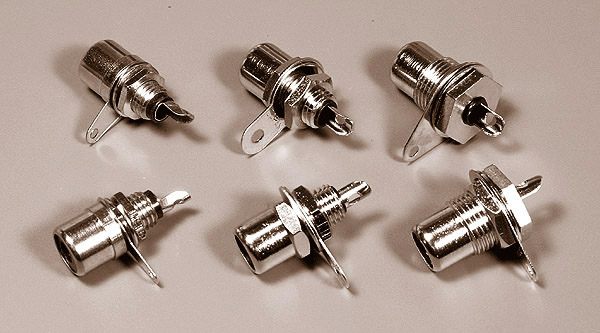
From left to right:
- The common phono jack, available everywhere, mounts in a 6-mm or 1/4-inch hole and
tightens with an 8-mm wrench. To grip the front part, so that you have
something to tighten against, you should use rubber-jawed pliers (which can be
carefully adjusted Vise-Grips with electrical tape inside the jaws). A lockwasher is often provided
and is very much needed because otherwise you'll never get the nut tight enough.
- The hex-based variety is grippable both front and back, with a 9-mm nutdriver
and/or open-end wrench, which makes it much easier to tighten.
It mounts in a 1/4-inch or 6.5-mm hole (not 6-mm).
This is Mouser 161-1052,
made by Kobiconn, and costs about 82 cents. Similar products are sometimes available from other suppliers.
- Best of all is the rear-mount phono jack, which can be tightened from outside the
equipment without rotating it (just grip the round part with rubber-jawed pliers
while applying an 11-mm or 7/16-inch wrench to the nut). Further, like a potentiometer,
it can be removed from the panel without disconnecting any wires. It mounts in a 3/8-inch
hole.
This is Mouser 16PJ035,
made by Kobiconn, and costs about $1.41. Rear-mount phono jacks are also made by Switchcraft.
Despite the cost, the rear-mount phono jack is the only one I want to use in highly portable equipment
because it's the only one that can be tightened up from outside without risking any
damage to the wires hidden inside the equipment. Also, the ability to attach the wires before
mounting it to the panel greatly speeds construction in some situations.
Permanent link to this entry

|
 |
2006
June
10
|
Internet Explorer closes suddenly when you click on a button
This strange problem appeared on one of our computers on which we had just reinstalled Windows.
Symptom: Go to www.amazon.com, type a name in the search box, and click on "Go."
Internet Explorer disappears from the screen as if you had closed it.
Cause: This indicates a problem with the Java execution engine. Thanks to lawsuits, Microsoft can
no longer require everyone to use the Microsoft Java engine. The rival engine from Sun
(www.sun.com) is also widely used.
Fix: In the Start Menu, choose Set Program Access and Defaults and make sure the Java engine
that is selected is one that is actually installed on the machine.
Permanent link to this entry
Is top-posting evil?
Some people reply to e-mail and Usenet discussion messages by "bottom-posting," adding a reply
at the bottom. Others "top-post," adding the reply at the top.
I do both, as well as "interleaved posting," inserting replies between parts of the quoted text.
Recently some old-timers on sci.electronics.design have been trying to tell us that
top-posting is wrong and contrary to the accepted practices of Usenet.
Why?
Apparently because, on a non-threaded newsreader of 1980 running on a 1975 DECwriter terminal,
top-posted replies are hard to read. You have to print out the whole message and read everything
in order. That is the Sacred Tradition Which Must Never Change.
Bah, humbug! I'm an old-timer myself (programming since 1973), and I get tired of people
telling me I need to live in the past.
This is not 1980, we do not have non-threaded newsreaders, and we
do not print messages out on paper in order to read them!
With today's technology, it is quicker to write – or read – a snappy reply right at
the top, where it's immediately visible, leaving the quoted material for the reader to either
scroll through or not, as he wishes.
The question I would put to the bottom-posting chauvinists is:
Why do people top-post? If you don't know, then you have no idea what you're criticizing.
Permanent link to this entry
Here come the language lawyers
A "language lawyer" is an expert on the official specifications of a programming language,
especially one who makes a pest of himself displaying his expertise.
Well... The opposite of the bottom-posting chauvinists that I just mentioned are the new
generation of HTML language lawyers.
HTML, the language of web page design,
has undergone a number of changes since it originated, but the Web relies on total
upward compatibility.
Any web page that ever worked will still work. We'd be up the creek if it didn't.
Unfortunately, the authors of perfectly good web pages are now getting flak from
people who run their work through syntax testers and announce smugly that such-and-such a page
does not conform to next week's version of XHTML.
Starting next month, this page will be re-engineered to pass an HTML 4.0 syntax check.
But I'm not moving to CSS or XHTML just because they have been invented.
Permanent link to this entry

|
 |
2006
June
8-9
|
Cotopaxi

Smithsonian American Art Museum
We spent yesterday packing Cathy off to Ecuador to join a group from the University of Georgia School of Art.
She spent last night in the Posada de Tigua, which, I'm told, has changed little
since Frederic Edwin Church painted it in 1855. It is the building at the lower right in this
famous picture of the volcano Cotopaxi.
Permanent link to this entry
Miscellany
Fake "shake" flashlights:
For a year or so, flashlights have been on the market that are powered by a magnet which you
shake back and forth within a coil. They use supercapacitors to store enough electricity to shine
for a few minutes.
Well, now I'm hearing reports that fake flashlights of this kind are turning up at
flea markets. They have a coil and a magnet for show, but they're actually powered by a hidden
battery which eventually runs down.
Medical mystery: a disease known as "Morgellons" (not a person's name, but an old French
name for the disease). It may just be delusional, or it may be a real disorder of the connective
fibers underneath the skin; the controversy is summarized
here.
My two cents' worth: Don't assume that all these patients have the same disorder.
Permanent link to this entry

|
 |
2006
June
7
|
24 hours of fame
June 6th was this Daily Notebook's day of glory, with about 2000 hits in a 24-hour period.
(And I didn't even have Google Ads enabled.)
I want to thank Jonathan Adler of
The
Volokh Conspiracy – a major law-and-public-affairs blog – for referring gazillions of
people to yesterday's entry.
If you like recursion, you can click on the link I just gave you, then click on the link there to
come back here, then scroll up a little and...
Permanent link to this entry
"The remote computer has ended the connection"
If you get this message the moment you make a Remote Desktop connection to a Windows XP SP2 machine,
you've fallen victim to a
known bug in SP2.
(The message indicates that you have made a connection, so apart from this bug,
Remote Desktop Protocol is working correctly.)
In my case, Microsoft's registry workaround didn't work, and I had to
resort to
Thomas M. Turner's solution,
which was to boot up Recovery Console and replace
termsrv.dll with the pre-SP2 version.
The Daily Notebook may soon be available via RSS.
Some of my friends have been clandestinely converting it, via a Perl script,
and I'm probably going to install the script on my own (ISP's) server and make it
publicly available.
What you get is slightly scruffy but can be read very quickly, and then you click on
a link if you want to see an article in its full glory, with pictures.
I know I'm posting these entries ahead of the dates on them, but after all,
yesterday's topic was prophecy, wasn't it?
Permanent link to this entry

|
 |
2006
June
6
|
No, today is not 666
Today is 06/06/06 whether you write the date forward or backward.
Is there anything evil about this date?
No.
The Bible predicts an ungodly dictator (the Antichrist) whose "mark"
will be the number 666.
This is part of a very allegorical description
given in Revelation 13,
which describes a "beast" and starts out, "It had two horns like a lamb and it spoke like a dragon" (ESV).
Christians agree that this is a warning about a future earthly ruler,
not a giant horned reptile. It is part of St. John's vision, in which various
spiritual forces are represented by dramatic visual images.
The number 666 is given in verse 18:
"This calls for wisdom: let the one who has understanding calculate the number of the beast,
for it is the number of a man, and his number is 666."
Not six-six-six, but six hundred sixty-six,
which in Roman, Greek, or Hebrew numerals is not written as three sixes.
(For example, in Roman numerals, 6 = VI and 666 = DCLXVI.)
And in some manuscripts of the New Testament, the number is given as 616.
Hebrew, Greek, and Roman numerals consist of letters from each respective language's alphabet.
Especially in Hebrew and Greek, ordinary words can be assigned numerical values.
You can do that with Roman numerals if you simply skip the letters that are not numerals,
which are many.
Over the years, people have tried to deduce 666 as the numerical value of all sorts of names,
including "Vicarius Filii Dei" (a title of the Pope), "Martin Luther," and "Henry Kissinger."
But the most convincing explanation I've found is that 666 is what you get when you
transcribe "Nero Caesar" into Hebrew (נרון קסר) and then interpret it as a numeral.
What is particularly appealing is that if instead of the Latin stem Neron-
you transcribe the nominative form Nero,
you get נרו קסר, which comes out to 616, the number found in some of the manuscripts.
So in Verse 18, St. John was warning us about dictators like Nero, but
hiding his message from the Roman authorities.
This is a genuine use of a code in the Bible. Da Vinci Code fans, enjoy it.
But the point is that the Bible says nothing about the series of
numbers six-six-six and certainly does not tell us to shun the number 666
everywhere it occurs.
Since 666 is now a widely recognized symbol of evil, one might want to avoid people who
are inordinately fond of it. But that is because of the cultural symbolism, not the Bible.
Bible quotations are from the
ESV,
a translation I find particularly accurate, although (and because)
it does not differ significantly from other widely respected translations.
Permanent link to this entry

|
 |
2006
June
5
|
Should chemistry be banned in the United States?
A recent
article
in Wired
puts its finger on something I've been worried about for a long time:
It no longer seems to be entirely
legal for a private individual to do chemistry experiments.
There is a presumption that anything resembling a chemistry lab,
if found in a private home, is either a terrorist bomb factory or a meth lab.
In the public mind, it's a matter of appearances.
You can buy very dangerous compounds at the grocery store or garden center.
In the eyes of scientifically illiterate bureaucrats
(especially on the local level),
"swimming pool pH reducer" is fine but "hydrochloric acid," on the other
hand, is a chemical used by terrorists, or drug manufacturers, or something.
(The two are, I hasten to point out, the same substance.)
You can buy plenty of
things that are very dangerous – chain saws, for instance –
without any restrictions at all.
But if you buy or sell "chemicals" (defined as things that look like they
might appear in the opening
scene in Jerry Lewis's The Nutty Professor
of 1963), you're under suspicion.
Not all the bureaucrats are scientifically illiterate.
At the next level up, there is reportedly a presumption that if anything can be
used destructively, that's what it will be used for.
Nowadays, people are being questioned about sulfur because it can be used to
make bombs. Never mind that it has plenty of other uses (I've used it as an old-fashioned,
and extremely safe, insecticide).
There is also a lot of confusing inter-agency rivalry.
The Wired article describes a raid, by one federal agency, on someone who might
have been selling something that could have been used to make fireworks –
while at the same time he was a valued supplier of essential items to other federal agencies!
(I understand that part of this story may have been a smokescreen. There may have been better
"probable cause" than it indicates. But if so, we need assurances that the police will not
raid harmless experimenters or dealers of ordinary scientific supplies.)
We must beware of what I call the anti-freedom principle, best
articulated as, "If I don't want to do X then nobody has any business doing X."
This is an attitude held by fashionable people who don't realize they're inadequately
educated, people who assume that the only worthwhile
human activities are those of their own in-crowd. Yuppies, in other words.
I hasten to add that I'm not a chemistry experimenter myself
(although in my darkroom I do make my own stop bath, and for that purpose,
I have jars of citric acid
and succinic acid from lab chemical suppliers).
I mix developer in Erlenmeyer flasks, which lends a slight Nutty Professor
look to the lab, er, darkroom.
I hope nobody ever mistakes it for a meth lab.
What I'm worried about is that hobby electronics will be next.
We already have people ready to assume that anything with a circuit board and wires
must be a bomb.
(Bomb squads have been called to discarded transistor radios and the like.)
How long before Radio Shack has to stop selling "bomb-making parts," which unfortunately
include practically everything electronic?
The Wired article also
focuses on the chilling effect on science education of excessively heavy
restrictions on common lab supplies.
I don't want students exposed to undue danger, but let's be realistic.
A chemistry lab is not a padded cell, any more than a woodworking shop is.
If students can be trusted with tablesaws, then surely they can be trusted
with acetic acid.
There is some pressure on educators go back to the Middle Ages and have science students sit around and
philosophize about what ought to happen (nowadays greatly aided by computer simulations)
instead of looking at actual matter to see what does happen.
In that environment, you get sophisticated logic combined with terrible scientific misconceptions.
Of course, nobody today views it as going back to the Middle Ages. They view it as "safety."
What I would like to ask for is assurances from government agencies that, in fact,
they are not persecuting people merely for being interested in science,
and that their local functionaries are educated accordingly.
I'd also like to see consistent laws and regulations that can all be found in one place,
so that a conscientious citizen can obey them and avoid nasty surprises.
And if, when gathered into one place, the regulations don't make sense – well, then,
change them.
Permanent link to this entry

|
 |
2006
June
4
|
Almost as old as I am
Heathkit AG-9A audio signal generator
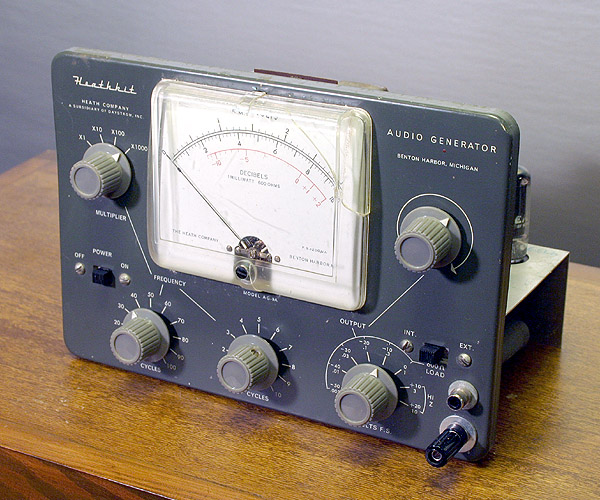
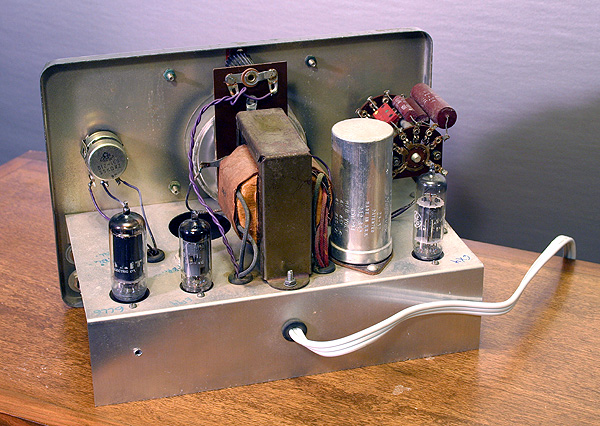
Back in January I discovered a problem with my
vintage Heathkit audio signal generator, or thought I did.
I measured something like 240 volts AC between circuit ground of the signal generator and
circuit ground of everything else. Ouch! Panic!
Actually, nothing was wrong except that 1958 gear doesn't meet 2006 safety standards.
I was seeing some capacitive leakage through the transformer,
not capable of injuring a human being or any other 1958 equipment.
But it might well be enough to damage newer equipment.
So today, after confirming that there was
no resistive leakage (at least, nothing below 20 megohms) and nothing else wrong,
I modernized the power supply circuit to provide a proper ground connection
and a fuse (marked by arrows here).
Soon, but not right away, I'll replace all the electrolytic capacitors, though none
have given trouble yet.
Fortunately, there are no paper tubular capacitors.
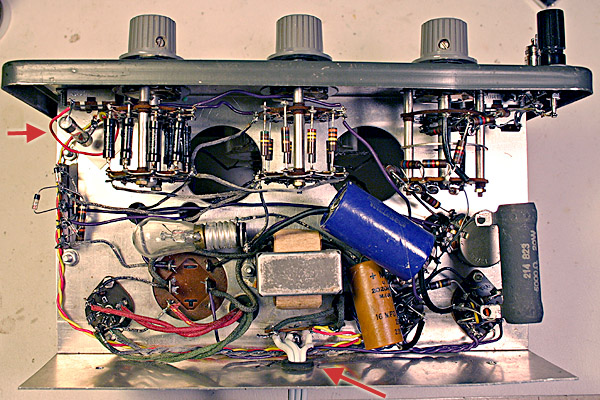
|
In the last picture you see what my workbench looked like during some of the testing.
The combination of a vacuum-tube signal generator and a digital oscilloscope may amuse you.
The AG-9A has remarkably low harmonic distortion (<0.1% claimed).
I bought it at a hamfest about 10 years
ago and continue to use it. Being no fool, I have a Hewlett-Packard 204C (?) also on hand
for audio testing, but the AG-9A is more self-sufficient, and for audio work, it fills a
forgotten niche. I'm giving some thought to how to
build an instrument for the same purpose with modern technology.
More AG-9A information is available
here,
here,
and
here.
|
|

|
Permanent link to this entry

|
 |
2006
June
3
|
Non-contact thermometer
 A few months ago, at Fry's, I bought myself a non-contact infrared thermometer.
Today I got it out and started finding uses for it.
A few months ago, at Fry's, I bought myself a non-contact infrared thermometer.
Today I got it out and started finding uses for it.
(This thermometer can be bought from
tequipment.net,
an interesting company I've not yet done any business with,
and from
Digi-Key,
which is very reliable.)
By sensing infrared radiation, it tells you the temperature of a nearby solid object
(not IR-transparent objects such as air) from an inch or two away.
What I'll use it for the most is probably checking whether electronic components
are heating up when they shouldn't be, or are getting hotter than they ought to.
Unlike your finger, the thermometer doesn't get burned if the object is hot,
and it's much more sensitive.
One interesting project would be to aim it at all the electrical outlets in the house
and see if any of them is emitting heat. That would be the first sign of a bad
connection.
Its other use is for checking whether my telescope has reached the same temperature as
the surrounding air. (The air can't be checked with this thermometer, but I can at least
track whether the telescope temperature is changing.) Temperature equalization is
necessary for steady views, and the cool-down process in the winter can take a couple
of hours.
It also occurred to me that a non-contact thermometer could be very handy in the kitchen.
Melody already uses a couple of different digital thermometers, one of them built
into a big fork, to measure cooking temperatures.
Permanent link to this entry

|
 |
2006
June
2
|
Miscellany from the world of electronics
Breadboarding product of the day:
Schmartboard EZ.
This is a ready-made printed circuit board to which you can solder
surface-mount ICs.
What makes the soldering easy is that (1) the solder is already on the
board, so you only add flux and heat, and (2) more importantly,
the PC traces are surrounded by a raised
coating, so the chip stays in the groove!
Microcontroller of the day: Texas Instruments' MSP430 and its
$20 development kit.
This is a 16-bit CPU that sells for 55 cents [allegedly; I find it selling for about $3.75,
which is still impressive].
It runs on 3 volts (not 5) and is normally programmed with a C compiler.
I haven't tried one yet, but the obvious thing to do is hack the removable
target module in the development kit so that it will hold a 14-pin DIP
version of the chip (instead of surface-mount).
Then you have a really useful development programmer.
(Yes, I know, I haven't even tried the Atmel AVR yet,
and the chips and programmers have been
sitting in my office for a year! I have a backlog...)
Discrete semiconductor of the day: International Rectifier's
IRF3708,
a power MOSFET that switches fully "on" with 3 volts on the gate
(not 5 volts like the IRL series or 10 volts like most of the IRF series).
Useful as 3-volt logic circuits become more common.
Most amusing thing someone has built:
a digital clock implemented
entirely with vacuum tubes.
The writeup is in German, but the pictures speak for themselves!
Permanent link to this entry

|
 |
2006
June
1
|
Globular and galaxy

Here are two astrophotos from May 24, each a stack of multiple 3-minute
exposures (5 for the cluster, 9 for the galaxy).
The globular cluster M13
came out very well; the galaxy M51,
which is much fainter, was something of a challenge under our
bright city skies.

Both of these were taken with my 8-inch LX200 telescope, f/5.6 compressor,
and Canon Digital Rebel.
This time the autoguiding was done with my SBIG STV mounted piggyback on
the telescope, and its lens was an old objective from a pair of cheap binoculars,
attached with a creatively misused
Meade eyepiece projection adapter
(which happens to screw right into the STV camera)
and a
threaded adapter made for me by Pete Albrecht.
That is, I built a gadget like an
SBIG eFinder.
To my delight,
it worked very well. Here's what it looks like in use:

(Despite what it looks like, the autoguider is not held on by the Velcro strap!
That strap is a
Kendrick dew remover
heating element, for which I built my own controller.)
Because of its wide field, this gadget can find a guide star anywhere it's aimed.
And because of the subpixel position computations of the STV, it's actually
beneficial that the star images are slightly blurred and fall on more than
one pixel of the image sensor.
If the whole image is on one pixel, you can only judge its position to 1 pixel
of accuracy.
But if 39% of it is on one pixel, and 50% on another, and 11% on a third one,
you can interpolate its true centroid to a precision of much better than one pixel.
In that way, the STV can guide a big 8-inch telescope (to 1.5 arc-second accuracy)
with a little 30-mm-diameter lens.
By the way, I did compare the results with the guider to
the unguided
pictures I was taking with the same telescope recently
(relying on its precise drive and precisely aligned pier).
The autoguider definitely helps.
Permanent link to this entry
Miscellany
Until I read
this,
I had no idea bears were extinct in Germany.
Human beings have really run off all the wildlife from Europe!
One of the best blogs I've come across lately is
Joel on software,
part of which has now been published as a book.
One of Joel's best points (in the book) is that
Microsoft succeeds because it's run by a programmer.
Back when Apple's CEO (borrowed from a soft-drink company),
was trying to produce an impossibly good handwriting recognizer
(the Newton), without any real awareness of why it didn't work well,
Bill Gates was asking his programmers to invent
the RichTextBox
so that all kinds of software can have word processing
built in. A big difference in outlook!
Here is the
unusual
optical instrument of the day.
I haven't used one.
It has an unusual eyepiece that you look into with both eyes.
Permanent link to this entry

|
 |
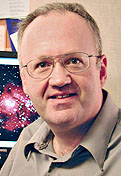

![]()



 As everybody knows by now, Jupiter has grown a
As everybody knows by now, Jupiter has grown a











 A few months ago, at Fry's, I bought myself a non-contact infrared thermometer.
Today I got it out and started finding uses for it.
A few months ago, at Fry's, I bought myself a non-contact infrared thermometer.
Today I got it out and started finding uses for it.


